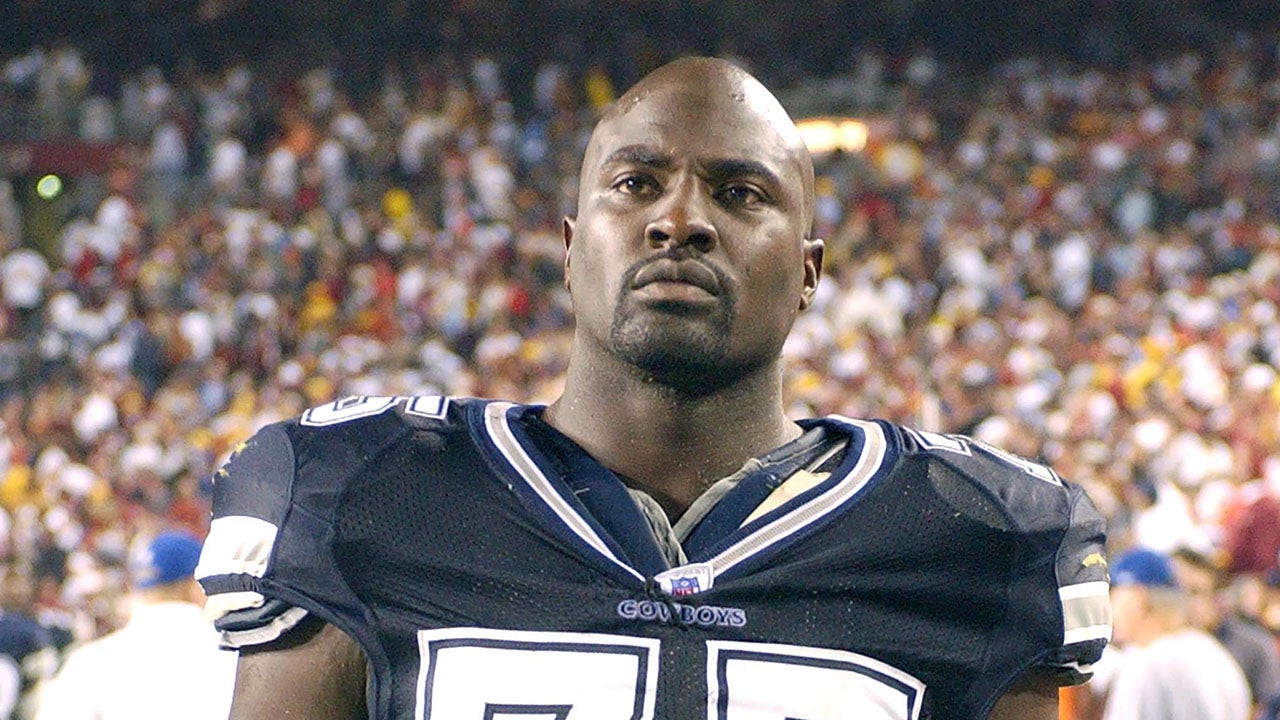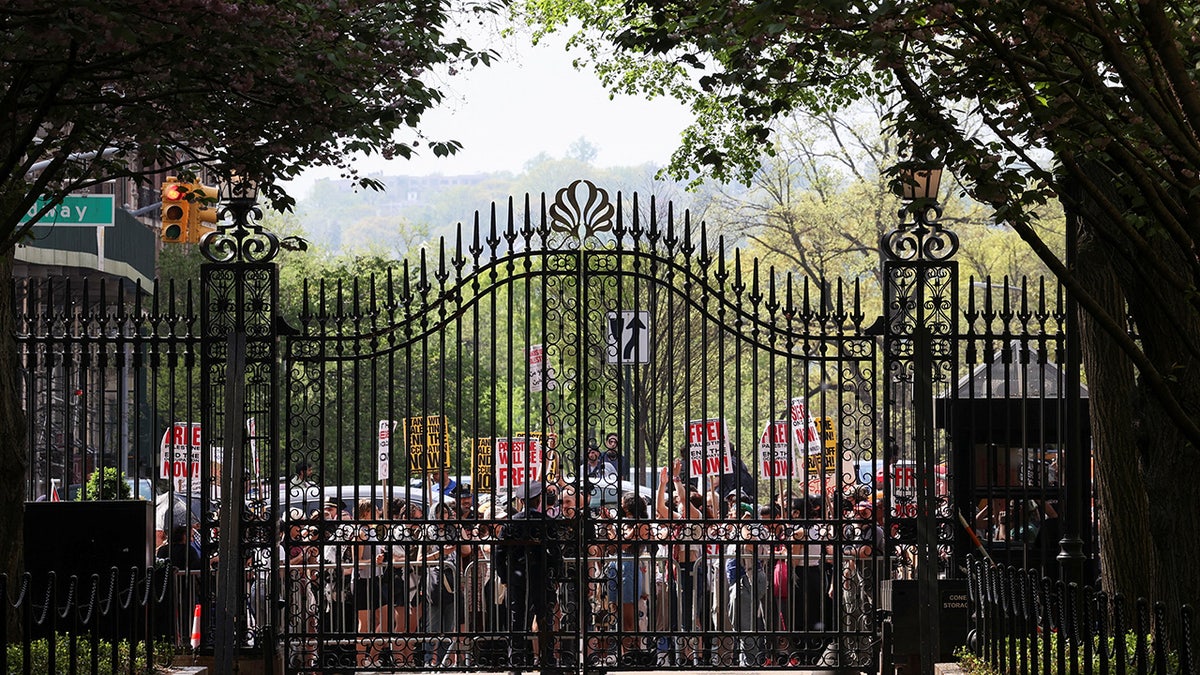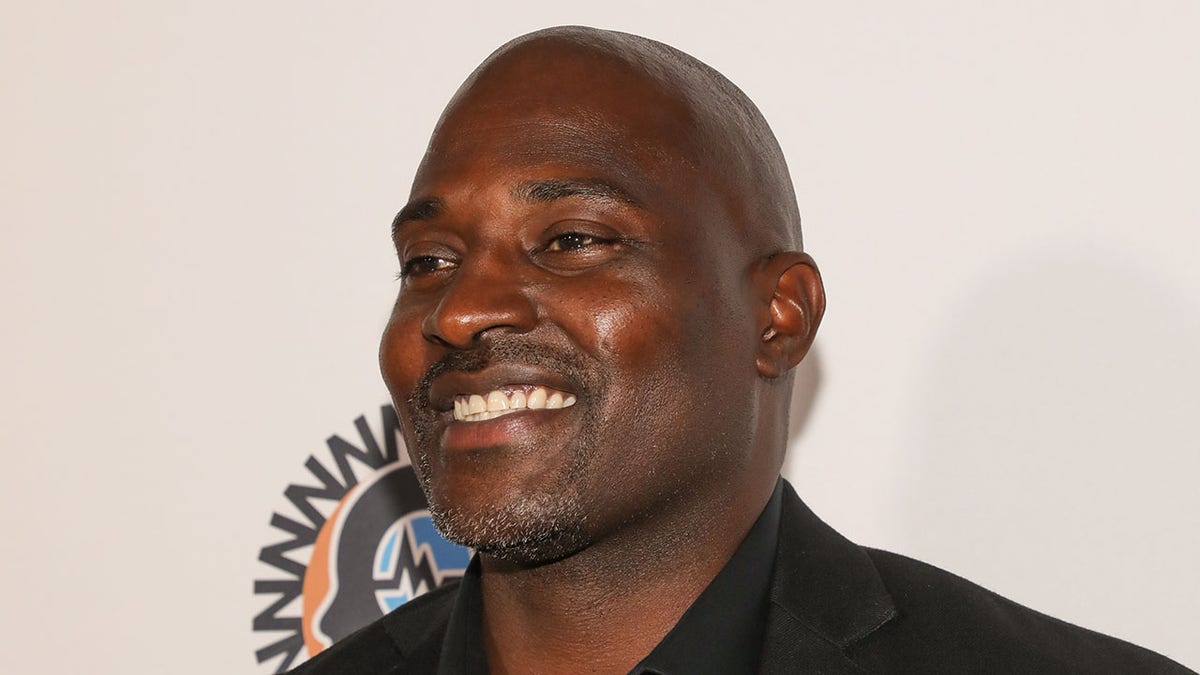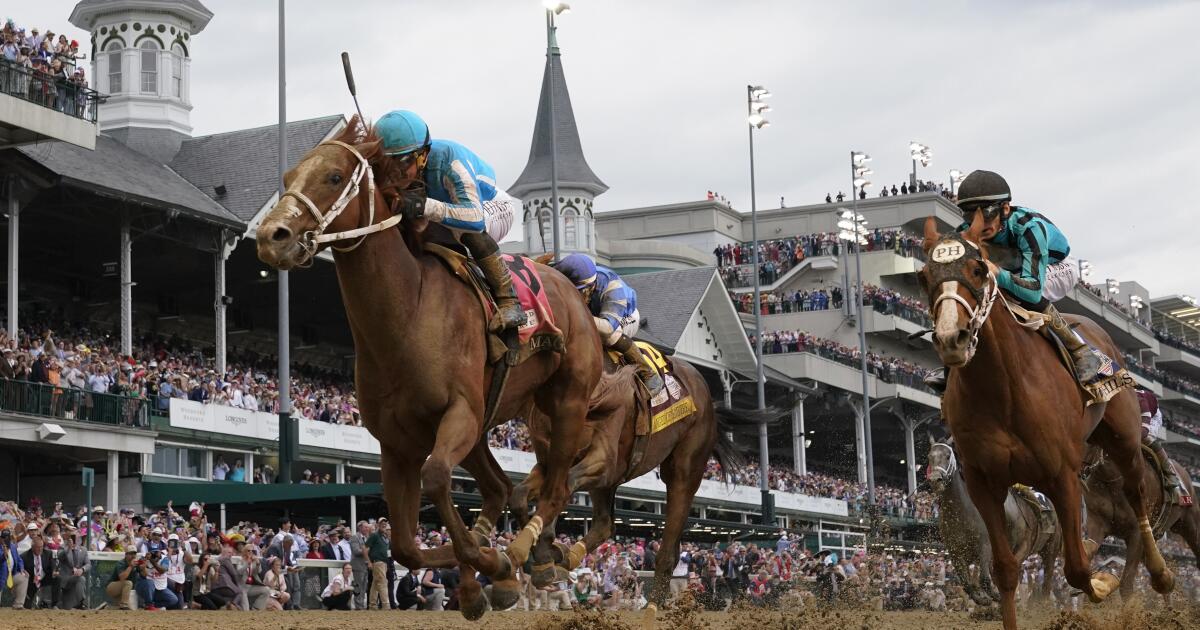Sports
The Arizona Coyotes are gone. Someone please tell ex-owner Alex Meruelo

True to form, Alex Meruelo was defiant.
Whether in a meeting with Arizona Coyotes employees last Thursday or during a local radio interview later that afternoon or as he was sitting next to NHL commissioner Gary Bettman at a hotel in Phoenix the following day, Meruelo, the owner of the Coyotes since 2019, reacted to being forced to sell the franchise by the league by insisting he hadn’t lost it at all.
Sure, the Arizona Coyotes were moving to Salt Lake City. Sure, players and hockey operations employees were already meeting with a new owner and making plans to visit their facilities in Utah, and, sure, season ticket holders in Arizona were wondering when they would be refunded the deposits they’d put down for next season, but Meruelo’s relationship with that reality was, at best, casual.
On the “Burns and Gambo” radio show, he corrected one of the show’s hosts, insisting he was still the owner of the team, which was now simply “inactive.” He said he merely sent “players and hockey operations to Utah.” In the meeting with staff the next day, he told employees, who were worried about their jobs, that he refused to go down as the guy who lost the Coyotes. In a news conference with Bettman on Friday, the commissioner interjected on multiple occasions, jumping in to “translate” when Meruelo blurted out “I don’t like the media.” At one point, Bettman grabbed Meruelo’s arm to stop him from talking.
A thriving NHL franchise in Arizona has long been an oasis the league toiled toward. It is a vibrant market with a robust youth hockey scene, and it has long presented an opportunity to diversify hockey’s fanbase. But since the club’s inception in 1996 (the club moved from Winnipeg where it previously played as the Winnipeg Jets), the league and Coyotes fans have endured much in pursuit of that dream. There was a failed attempt to build in Scottsdale in 2001 and a move to Glendale in 2003. Six years later, in 2009, the NHL had to take control of the franchise after the team’s third owner put the team into bankruptcy. The past two seasons, the Coyotes played out of a 4,500-seat college facility after getting kicked out of their former arena following a battle over unpaid arena charges and more than $1.3 million in delinquent tax bills.
In forcing the sale of the Coyotes to Ryan Smith, owner of the NBA’s Utah Jazz, the league finally pulled the plug on its Arizona dream — at least for now. At the center of that failure is Meruelo. He was viewed as a potential savior of the franchise when he bought the team five years ago but became the final nail in its coffin, failing and defiant to the end.
Tact and grace were never Meruelo’s preferred approaches.
He made his wealth in real estate development and construction and also owns media companies and casinos. He was the first Hispanic owner to hold a majority stake in an NHL club — one located in a market that was, at the time he purchased the team, 42 percent Hispanic or Latino. Xavier Gutierrez, his top lieutenant and a longtime Meruelo confidant, became the league’s first Latino CEO and team president. Both were emphatic about their desire to connect with the fan base and rolled out a number of community-oriented initiatives to achieve the goal. Despite the fact Meruelo had a deal fall through for an NBA franchise years earlier (according to one report, the league felt the deal was too highly leveraged), the NHL hoped his deep pockets and reputation for revitalizing distressed assets would finally lift the franchise to stability.
It took just over a year for that optimism to crack. In August 2020, reports surfaced that he failed to pay players signing bonuses. Gutierrez blamed it on their lack of experience owning a sports franchise. As more vendors and employees began cropping up with complaints about unpaid invoices and strongarm tactics, it became clear that it was a feature of Meruelo’s business practices, not a bug.
Finding a long-term home for the Coyotes under Meruelo’s ownership quickly developed into his most vexing problem. In his first news conference, he addressed the need for a “financially sustainable” solution to the team’s arena woes. Given his real estate and construction background, there was optimism he’d be able to build a state-of-the-art arena as part of that plan. But as word of his business tactics made the rounds, distrust within the business and political communities grew. Instead of trying to forge inroads with power brokers and rebuild his reputation among local leaders, he was brash and arrogant. Former Tempe city councilmember Lauren Kuby recalled an interaction in which Meruelo remarked: “I bet you’ve never met a billionaire before.”
In February 2021, The Athletic published a report that Meruelo’s first 18 months of ownership was marred by a revolving door of executives, strained relationships with corporate partners, and a litany of financial issues, some made worse by the pandemic. The story, which drew from interviews with more than 50 people, detailed a pattern of unpaid bills and jilted vendors, a disastrous draft pick that earned them universal scorn and employees complaining about a toxic environment.
At a company draft party in the summer of 2021, he unexpectedly took the microphone, telling the crowd the team would leave Glendale and build a new facility in Tempe. Executives in attendance, including Gutierrez, grew visibly uncomfortable at his bombastic speech given the team’s fragile relationship with Glendale and the corporate partners in the audience.
“That was one of the first signs I had that we were really in trouble,” said a former employee. “He had no self-awareness whatsoever.”
Later that summer, the Coyotes were told they were being kicked out of their Glendale arena after the 2021-22 season, with the city manager describing the situation as the “point of no return.” Meruelo had played hardball in lease negotiations, certain the City of Glendale would never boot him from the building. For a man who owns casinos, he was an ineffectual bluffer.
It was a massive misstep. It meant the franchise had no suitable place to play while Meruelo attempted to get politicians, unions and voters behind a $2 billion development plan in Tempe that included a new arena. As he worked to secure that project, Meruelo’s years of hubris came back to bite him. Grassroots organizers pounded his track record and credit rating, citing a financial analysis commissioned by the Tempe City Council. Campaign materials characterized him as “corrupt,” “scandal-plagued” and a “deadbeat billionaire.” Local trade and worker unions lobbied against the plan. And Meruelo didn’t dive deep into his coffers to counteract that negative messaging. He said last week he poured $7 million into the referendum; campaign finance records show that he spent just over $1 million.
In May 2023, voters rejected the proposal, leaving the team again with no clear path to a suitable arena.
“I think the narrative in Tempe … is that they botched this campaign,” said Randy Keating, a Tempe City council member who supported the development proposal. “And they did.”
The clock on relocation began ticking once the proposal was voted down, yet Meruelo remained undeterred. In early March 2024, news broke that the team was eyeing state land in north Phoenix. The team was initially considering a 200-acre parcel in that area but that plan was “pared back” because of high infrastructure costs, Gutierrez later told The Arizona Republic. But bidding on the land required months of public notice; by the time the team secured a place on the agenda with the Arizona State Land Department in mid-March, the timeline became too “stretched,” according to Bettman.
In January, Ryan Smith publicly stated his intention to bring a team to Salt Lake City. In February 2023, NHLPA executive director Marty Walsh blasted the Coyotes and made it clear that the situation was untenable. He stressed the urgency of addressing the matter and applied pressure on the league to take action.
On March 6, Bettman and deputy commissioner Bill Daly met with Meruelo and asked whether he could look his players in the eyes and give them an honest answer of when they’d have an NHL-caliber home. He told them he could not. Over the next five weeks, a deal came together to send them to Utah for the 2024-25 season.
In a news conference on Friday, Bettman said the league decided it wasn’t fair for players to continue playing in a facility built to accommodate ASU’s hockey team and one-third the size of most of the league’s arenas. Meruelo called selling the franchise the most “painful decision in his life” — even though it was arguably not his decision.
NHL Commissioner Gary Bettman (right) speaks alongside Coyotes owner Alex Meruelo during a news conference in Phoenix last week. (Christian Petersen / Getty Images)
As part of the sale, Meruelo will be given the exclusive right to bring a team back to the market, an effort that begins with the state land auction on June 27. Bettman said the league needs 18 months notice prior to reactivation and PHNX Sports reported that any arena must be 50 percent complete in order to trigger reactivation notice. According to Sportsnet, the “revival rights are non-transferable” and the $1 billion price tag to bring the Coyotes back is locked in. It is a path back into the NHL for Meruelo, but few people believe the league would allow that to happen.
“I have not witnessed a group more committed to doing things the wrong way and failing to develop any sort of meaningful support in the political community, business community and with the influential stakeholders they need to make this happen,” said David Leibowitz, a former communications consultant for the Coyotes who worked with three different owners, including Meruelo.
Said Keating: “I have zero faith they will be able to pull that off. The fact that he couldn’t build an arena when he had a team. Who’s going to build it now?” He added: “No one wants to do business with this guy. Why would you?”
Meruelo still exits with a golden parachute. Ryan and Ashley Smith of Smith Entertainment Group (SEG) purchased the team for $1.2 billion, $200 million of which will reportedly be divvied up among other NHL owners. Meruelo purchased the team for close to $450 million, according to two people familiar with the team’s finances. Even taking into consideration the franchise’s existing debts and yearly operating losses — which ranged from $50 to $70 million, those sources said — Meruelo is likely to net several hundred million dollars. One former employee, made aware of that fact, likened Meruelo’s tenure to that of a teenager who wrecks a car and then gets compensated with a Ferrari.
Employees within the franchise’s business side have been told their jobs are safe until the June 27 land auction. Meruelo said on Friday that those jobs will be evaluated over the next 60 days but that his intent “is to keep everything intact.” Those who remain behind have been told to focus efforts on the Tucson Roadrunners, the Coyote’s AHL affiliate that Meruelo still owns.
Last week, many of those employees and others from the past were at the anger stage of grieving. On social media, one former employee described a stint working for the organization as the worst four months of her life. A former in-game host revealed on X that the team tried to avoid paying the full amount of what she was contractually owed. Many employees attended the team’s final game in Arizona last Wednesday. Meruelo was conspicuously absent. He later claimed he didn’t attend because he was hammering out the final details of the sale of the team. In his absence, the mood was more Irish wake than funeral. Diehard fans stuck around for the final buzzer and long afterward. Players stayed on the ice in their gear and signed autographs. Employees congregated on the ice until their feet grew cold.
One young fan held up a sign that featured a border of Coyotes player photos. “THANK YOU FOR HELPING ME FALL IN LOVE WITH HOCKEY,” he wrote. In the center of the sign was a picture of Meruelo. Under that picture, in red, were the words:
“NOT YOU.”
— The Athletic’s Chris Johnston contributed to this report.
(Illustration: John Bradford / The Athletic. Photos: Norm Hall, Scott Taetsch / Getty)

Sports
Why a 5-foot-6, 160-pound SEC walk-on who can't attend most games wouldn't stop until he made the team

COLLEGE STATION, Texas — Sam Salz emerged from Texas A&M’s Bright Football Complex at dusk in early February, eager to explain how he got here.
“Over there,” he pointed, patting down his yarmulke with his other hand. “That’s where it happened.”
The patch of land in the distance sat adjacent to where the Aggies football team practiced. Salz, just a student with a dream in the spring of 2021, would arrive at the field every day an hour before Texas A&M practiced and stay an hour after the practice concluded.
A 5-foot-6, 160-pound Orthodox Jewish student who had never played organized football, Salz intended to try out for the SEC program as a walk-on. He worked on getting into shape and getting faster, even if he didn’t know how. He used old shoes instead of cones for drills. He lined up trash cans to simulate the line of scrimmage. He had no cleats. He didn’t even have a position to practice. He just worked.
A graduate of Kohelet Yeshiva High School — a Modern Orthodox college prep school in Philadelphia with roughly 100 students that did not field a football team — Salz had an improbable mission. And, like always, he had a plan.
Salz thought if he showed up every day and worked out as if he were on the team, he’d be noticed. But he didn’t leave it to chance. That fall, he attended then-head coach Jimbo Fisher’s weekly radio show at Rudy’s Country Store and B-B-Q to meet the man who would determine his fate.
“I walked up to him and looked him in the eye and said, ‘I’m Sam Salz and I’m going to walk on to your football team,’” he recalled, ignoring a team policy requiring walk-ons to have played varsity football in high school.
Fisher looked back at the undersized Salz, being more gracious than serious, and replied, “I’d be honored.”
Salz kept returning to the radio show, the same way he would to that patch of land. He approached Fisher again and asked if he could attend practice to better understand what the Aggies did. Salz scribbled down what he learned and incorporated it into his independent workouts.
The field Salz used was separated from the Aggies practice fields by a chain-link fence.
“I told myself, ‘I’m on this team,’” Salz said. “They are practicing on that side of the fence, and I’m practicing on this side of the fence, but I’m on the team. That was my firm belief. I’d practice, and the energy was great. Guys would come out of practice and realize this guy in a yarmulke was working out every day, and they’d hype me up. Coaches would notice. I’d talk to the coaches.”
Salz didn’t realize the coaches were talking about him, too.
Salz, 21, became obsessed with playing college football at a young age, for reasons he can’t exactly pinpoint.
“People talk about ‘Rudy’ to me all the time,” Salz said of the popular motion picture about a Notre Dame fan willing to do anything to make the team. “It’s funny, I’ve never seen it.”
College football games largely fall on Shabbat — the Jewish Sabbath, observed from sundown Friday to sundown Saturday. As a result, he didn’t grow up watching the sport.
For an observant Orthodox Jew, Shabbat is an entire day meant for communing with God, whether it be studying Torah, praying or being with your community. Judaic law limits distractions. There’s no work, no lifting weights, no cooking, no cleaning, no business transactions, no usage of electricity and no riding in motorized vehicles, among other rules.
And, obviously no playing football.
Sam Salz can suit up for the Aggies only after sundown for Saturday games. (Texas A&M Athletics)
So, what drew Salz to Texas A&M?
While in high school, Salz — like many other kids — got swept into the Dude Perfect craze on the internet. A group of friends took the web by storm by recording trick shots and putting them on YouTube. Salz learned that the members of Dude Perfect — now headquartered in Frisco, Texas — were college roommates at Texas A&M. Salz became infatuated with the school, a former military institution known for big-time ambitions, revered traditions, oil tycoons and Midnight Yell on Friday nights and Aggies football games on Saturdays.

Sam Salz started out as a running back but is now a wide receiver for the Aggies. (Texas A&M Athletics)
He researched. The university has a total enrollment north of 70,000 students and there are an estimated 500 Jewish students on campus, according to the University’s Hillel website, less than 1 percent of the population.
He reached out to Yossi Lazaroff, the rabbi of the Texas A&M Chabad. He concluded College Station was the right fit.
“It was really about the culture, what the school represents and the alumni network,” he said. “It’s very different from any other school in America. It also has a strong Jewish community, even if it’s not large.”
Salz said he felt a desire to prove to himself — and to other Orthodox Jewish people — that religious beliefs don’t have to infringe on goals or pursuit of happiness. For him, for some reason, that involved football.
“I’ve always been a ‘see if I can do it’ type,” Salz said. “I don’t know how this got into my head. People think I’m BS-ing, but I always had this belief in my head, back to when I was a little kid, that I had to play college football or else I wouldn’t have done everything I could’ve — or should’ve — in life.”
When Salz was a child, his school held a fundraiser selling cookie dough. The student who sold the most won a flat-screen television. Salz became obsessed and, with the help of a family friend who was an accountant, devised a sales strategy.
“He won,” said his mother, Marianna Salz. “I’m of the mindset that if you want to try something, go ahead and do it. I know my son, so this wasn’t as big of a surprise and shock as it may have been for other people. He is a determined person. When he told me he wanted to do this, I was like, ‘OK, this is your next thing. Try it. Do it.’”
Even with all of Salz’s planning, he never realized Fisher could see him working out from his Kyle Field office.
“In the offseason, even on days we didn’t practice, he’d still come out there,” said Mark Robinson, Texas A&M’s associate athletic director at the time and currently the chief of staff at Florida. “There’s a balcony that overlooks the field. (Fisher) would see him out there and just say, ‘That’s the same kid who comes to the radio show. He’s always working out, and I love his drive.’”
When he first got to College Station in 2021, Salz took online classes at a Texas A&M system school and couldn’t try out for the football team until he became a full-time student on the main campus. And then before the 2022 season, Texas A&M had so many players in the program that it didn’t hold walk-on tryouts.
But during a difficult 2022 season — one that would include a six-game losing streak — Fisher wanted to make a statement to the locker room. He wanted someone like Salz, who wanted something bigger than seemed possible and was willing to work for it, on his roster.
“Halfway through the season, that’s when I got the text from Mark,” Salz said.
The text from Robinson was simple: “Sam, do you have some time to come by the football offices today or tomorrow?”
As Salz responded yes and received more information about the walk-on process, he couldn’t contain himself.
He screamed, jumped up and down and fist-pumped as hard as he could.
Fisher and Robinson invited him on the team, even though he lacked the size and the experience necessary to compete in the SEC.
“I don’t want to sound arrogant or self-aggrandizing when I say this. But there was something that I was willing to do that most people were not,” Salz said. “I made human connections and made myself a known person to them. I think (Fisher) appreciated that persistence. It was something old-school coaches would appreciate.”
Salz never hid his faith, proudly wearing his yarmulke and tzitzit, the head covering and the knotted fringes or tassels on the Jewish prayer shawl that serve as reminders of the 613 commandments in the Torah. But he was initially worried that the coaching staff wouldn’t be understanding of the time constraints of his religion and his need to eat only kosher food.

Sam Salz attended a high school with roughly 100 students. Now he is on a team that plays in a stadium with more than 100,000 seats.
Texas A&M, though, accommodated Salz. He isn’t expected to participate in team activities on Jewish holidays. The first practice after he was invited onto the team fell on Yom Kippur, and he didn’t attend. Team nutritionist Tiffany Ilten makes sure Salz has access to kosher meals, which they get from a distributor in Cherry Hill, N.J. A microwave in the team facility reads “kosher food only.”
“Our main priority was making sure that all of our student-athletes are fed and nourished,” Ilten said. “It was a challenge at first, but not in a bad way. It was just something new we all had to educate ourselves on.”
Salz and Robinson, who is also Jewish, connected by wrapping tefillin, small leather boxes and straps, around their arms and heads, symbolically binding themselves to God.
Salz, who remains part of the program after Fisher’s November firing and the hire of Mike Elko, started out as a running back. He was brought along slowly, still lacking foundational football knowledge and the physical makeup to run between tackles. The longer he has been on the team, the more he’s been incorporated onto the scout team, where he’s likely to make his biggest impact.
He moved to receiver, where Texas A&M needed depth. He understands his physical limitations when matching up with elite athletes. But as he talked about it, he reached into his pocket and shared a clip of him running a drag route in practice and making a nice catch.
“He goes hard all the time,” Texas A&M strength coach Tommy Moffitt said. “There is a size discrepancy between him and the other guys, but he doesn’t let that discourage him. The players have embraced him, and he works his tail off.”
Added former A&M wide receiver Ainias Smith, a fifth-round pick of the Eagles in the 2024 NFL Draft: “We needed somebody like that on the team. Once people get here, it seems like everybody feels like they made it. His story motivates us to keep going.”
Salz believes he is the only Orthodox Jewish player in college football. It’s not something that is tracked by the NCAA.
Perhaps the biggest challenge for him is reconciling that no matter how good he gets, he will always have restrictions on game day. If the Aggies play during the day, he can’t attend because he’s observing Shabbat.
For night games, he walks more than a mile from his apartment to Kyle Field. There are workers by the entrance who let him into the building — he can’t use his thumbprint scanners on Shabbat — and he finishes out the sabbath in the team rooms. He studies Torah, eats a meal and then gets suited up while the sun goes down. In the middle of the third quarter, he runs out of the tunnel and joins his team in his No. 39 jersey, yarmulke and tzitzit.
“My teammates joke that in the new NCAA video game that my rating should be a 99 overall but I can only be used in the fourth quarter of night games,” he said.
Salz has yet to appear in a game. He couldn’t participate in Texas A&M’s all-walk-on kickoff team (which paid homage to the 12th Man Kickoff Team from the 1980s) during its win over Abilene Christian last November because the game was during the day.
So why does he put himself through this routine if there isn’t the payoff of eventually playing?
“I know why I’m doing it: for my Jewish brothers and sisters,” Salz said. “I knew I’d be in a position to inspire a lot of people.”
(Top image Dan Goldfarb / The Athletic; Photo: courtesy of Texas A&M Athletics)
Sports
Former Columbia football star Marcellus Wiley discusses student protests: 'I'm disgusted'

Former NFL defensive end Marcellus Wiley said he is “disgusted” by the events taking place at Columbia University.
Wiley, who played college football at Columbia, recently joined Dan Dakich on OutKick’s “Don’t @ Me” to address the ongoing protests at the Ivy League university. Similar demonstrations have been happening at college campuses across the U.S. in recent weeks.
“I’m disgusted,” Wiley began. “I don’t pick the political side… it doesn’t matter what side you are politically on this one. You don’t have the right to protest and be unruly. Now peacefully protest, go do it.”
Marcellus Wiley #75 of the Dallas Cowboys looks on during a NFL football game against the Washington Redskins on September 27, 2004 at FedExField in Landover, Maryland. (Mitchell Layton/Getty Images)
Wiley argued that protesting was not the “end all be all.”
“I talk to these kids and I know my foundation, Project Transition, I’m always in the community and talking to these kids… half these kids don’t even know why they out there protesting. It’s unreal… like it’s insane.” Wiley told Dakich. “And the ones that do know also know that this is not the end all be all. There are other steps and measures you must take beyond protesting.”
PATRIOTS’ ROBERT KRAFT TAKES AIM AT COLUMBIA PROFESSORS AMID ANTI-ISRAEL PROTESTS
The former Buffalo Bills defender added that students’ actions could impact their future.
“So I don’t know why these kids are going to this extent… creating encampments, destroying their university, their property, their reputation, because when you leave people ask ‘Where did you go to school?’ and then their minds goes to two places. The positive, academic reputation, great curriculum…. and then awe Columbia… the place where all the protests, the place where all the kids can’t even be controlled, the place where the leadership didn’t step in fast enough, swift enough. So it damages your reputation, but we will rebound because we have to rebound.”

Demonstrators gather outside the main entrance to Columbia University in New York City, U.S., April 29, 2024. (REUTERS/Caitlin Ochs)
Wiley then pointed to Stanford University’s handling of student protests.
“I wish we would’ve handled it like Stanford. Saw some of the Texas schools, some of the Florida schools… Stanford wrote a letter, they said look before ya’ll go outside let me just let you know the rules of engagement… you are allowed to protest these hours, these places, go ahead. That’s what I wish Columbia would have did. And then after that if you want to violate these policies, there will be swift consequences.”

TV Personality Marcellus Wiley attends the Homeless Not Toothless Hollywood Event at The Beverly Hilton on April 22, 2023 in Beverly Hills, California. (Paul Archuleta/Getty Images)
Like at other universities across the country, some students at Stanford have created an encampment in the White Plaza portion of the northern California college campus to protest Israel’s military offensive in the Gaza Strip.
Stanford President Richard Saller and Provost Jenny Martinez said the student encampment violates polices that prohibit overnight camping on campus. The university has submitted the names of students caught violating campus policies to the Office of Community Standards (OCS) for disciplinary proceedings, they said.
Protest organizers have decried the university’s response to the student protests.
The Bills drafted Wiley in the second round of the 1997 NFL Draft out of Columbia. After a four-year run in Buffalo, Wiley went on to play for the Chargers, Cowboys, and Jaguars.
Fox News’ Louis Casiano contributed to this report.
Follow Fox News Digital’s sports coverage on X, and subscribe to the Fox News Sports Huddle newsletter.
Sports
What time does the 2024 Kentucky Derby start? What TV channel is it on?

The 150th running of the Kentucky Derby will take place Saturday afternoon, and the horses are scheduled to leave the starting gate at 7:03 p.m. ET.
If you are in Los Angeles (and who wouldn’t want to be there?), the race starts at 4:03 p.m. PT.
If you are in the Rocky Mountain area, say, Denver, it’s at 5:03 p.m. MT.
Say you live in Chicago, the race is getting later, and the horses leave the gate at 6:03 p.m. CT.
And finally, if you are at the Kentucky Derby, in the shadow of jacked-up hotel rates and full restaurants, the race starts at 7:03 p.m. ET.
And for bonus coverage, did you know that Newfoundland has a time adjustment of 30 minutes off of Atlantic time? Yes, should you be in Canada’s 10th province, the race goes off at 8:33 p.m. NT.
Now where do you watch the race. There are a couple of options. If you want to catch the first three races on the day’s card you watch them on FanDuel TV, which used to be TVG. They will have coverage all day but it may not always be live.
Then, starting at noon Eastern and 9 a.m. Pacific, you can catch the next four races on NBC’s baby network of USA. That goes until 2:30 Eastern and 11:30 Pacific when the big boys take over and it goes on NBC. And that lasts until 7:30/4:30.
Forgot your NBC stations. It’s Channel 4 in Los Angeles and New York, Channel 5 in Chicago and Channel 9 in Denver.
Once the USA coverage starts you can also stream it on Peacock until the big NBC stops coverage. Now, if all the time between races bores you, check out the series “Poker Face” with Natasha Lyonne also on Peacock. If you were a fan of the old Columbo series, you will love this show. There is only one season but a second season in the works.
As for radio? What is this, 1970?
Now, let’s say you are also interested in the lead-up to the race, let’s go over some other times. And for simplicity’s sake, we’re going to do it all in local time, with local meaning Louisville or Eastern time.
The first race of the day is at 10:30 a.m. The first stakes race, the Knicks Go, is at 12:04 p.m. At 6:16 p.m. the walkover for the derby horses from the barns to paddock starts. Then, at 6:28 p.m. the horses start arriving in the paddock. We’re now at 6:44 p.m. and Martha Stewart lights up the crowd with a “Riders up!” call.
Around 6:45 p.m. will be the call the post, that’s the thing with the bugler. Kentuckians get emotional at 6:46 p.m. with the singing of “My Old Kentucky Home,” followed at 6:48 p.m. with the post parade. The horses start to load at 7:02 p.m.
As for when to start your Kentucky Derby party, how about when you’re done reading this?
-

 News1 week ago
News1 week agoLarry Webb’s deathbed confession solves 2000 cold case murder of Susan and Natasha Carter, 10, whose remains were found hours after he died
-

 News1 week ago
News1 week agoFirst cargo ship passes through new channel since Baltimore bridge collapse
-

 World1 week ago
World1 week agoHaiti Prime Minister Ariel Henry resigns, transitional council takes power
-

 World1 week ago
World1 week agoSpanish PM Pedro Sanchez suspends public duties to 'reflect'
-

 World1 week ago
World1 week agoUS secretly sent long-range ATACMS weapons to Ukraine
-

 News1 week ago
News1 week agoAmerican Airlines passenger alleges discrimination over use of first-class restroom
-

 Movie Reviews1 week ago
Movie Reviews1 week agoHumane (2024) – Movie Review
-

 Education1 week ago
Education1 week agoVideo: Johnson Condemns Pro-Palestinian Protests at Columbia University


















